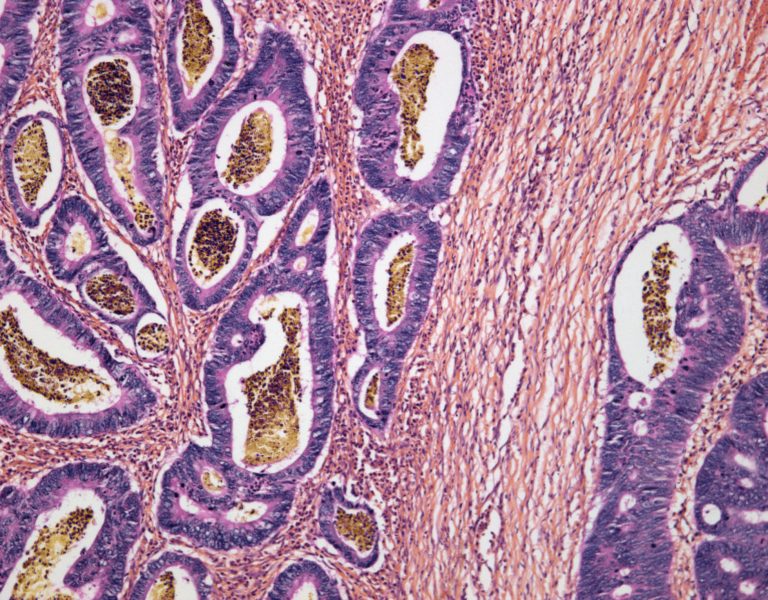
Circulating tumor DNA (ctDNA), which is DNA that has been shed from ruptured cancer cells into the patient’s bloodstream, has quickly emerged as a useful biomarker for numerous cancer types. Liquid assays have been developed to use ctDNA as a reliable, non-intrusive technique to assess the genetic mutations for some types of cancer, something that is very useful for determining personalized treatment options. Liquid assays can also be used to detect the very presence of ctDNA as a marker for cancer in the blood.
Previous studies have shown that checking the methylation profile of ctDNA can be used in the diagnosis, surveillance, and prognostication of a small number of cancer types, and a new study from Huiyan Luo and colleagues from China has shown the potential use of ctDNA methylation markers for colon-rectal cancer (CRC) surveillance and the efficacy of methylation markers in screening.
An accurate, blood-based ctDNA test for CRC would be a valuable tool for high risk patients as current methods of screening are either not sensitive enough (such as serum carcinoembryonic antigen (CEA) quantification biomarker testing) or highly intrusive and uncomfortable and thus avoided by patients (such as a colonoscopy). CRC is the 3rdmost deadly form of cancer because it is often found at a late stage and is in a location which makes surgical treatment difficult. An accurate, blood based test would be better tolerated by patients and thus make finding cancer at earlier stages easier.
Luo developed this new technique by first analyzing genetic data from the Cancer Genome Atlas and a cohort of patients with normal and CRC blood samples to decipher which genetic mutations, particularly methylation, correlated to CRC. Practically speaking, blood samples were taken from high risk patients and screened for ctDNA. Scientists could then create genetic algorithms by running statistical probability models to determine which sections of the genetic code were most likely to be involved if an individual had CRC. The information Luo and his team were searching for was then used to create a data model to test for the diagnosis analysis, prognosis analysis, and molecular subtype analysis within this patient population.
Once the data model had been built, it could be used to evaluate a new set of patients who were at high risk for CRC, but whose cancer status was currently unknown. Blood samples were taken from this group to conduct liquid biopsies and screen for the tale-tell ctDNA. This was a very methodology focused study, whose aim was to see if AI could determine which high risk patients had CRC and how to best treat it, with the results being compared to the gold standard of a colonoscopy.
This probability model was also looking to test the sensitivity and specificity of a methylation-based screening approach. Luo had used the model to pick a selection of methylation markers, and this lead to the discovery of a new ctDNA-based molecular subtype of CRC, though based on the sample population used (high risk CRC patients), this molecular subtype has not yet been verified. It was a surprise finding from this study, a single ctDNA methylation marker, that could yield high sensitivity (89.7%) and specificity (86.8%) for detection of CRC and precancerous lesions in a high-risk population. This information will undoubtedly be useful in future biomarker-targeted studies of CRC.
The rest of the results of this new methodology were also very promising: methylation of oncogenes and tumor suppressor genes may be present at early stages of malignant transformation, suggesting that methylation patterns could provide reliable, discriminatory markers for the detection and diagnosis of malignancy. Despite the known substantial variability in the somatic mutations of individual tumors, methylation patterns have been remarkably consistent, and it was possible to use nine selected cfDNA methylation markers to accurately discriminate patients with CRC from normal individuals. Additionally, the methylation information obtained suggests a correlation to the staging of CRC, so this model may be useful for the detection of residual tumor, the evaluation of treatment efficacy, and for surveillance of cancer recurrence.
The prognostic prediction model built from the data of this study used another five-marker panel to effectively distinguish patients with CRC with different prognoses, and validate them. Impressively, this model was found to be superior to CEA status, TNM stage, and primary tumor location prediction models.
While ctDNA has already emerged as a useful diagnostic and prognostic biomarker in other cancer types, this study has shown the obtained diagnostic prediction model can discriminate patients with CRC from normal controls with high accuracy and the prognostic prediction model can also effectively predict the prognosis and survival of patients with CRC.
This study has shown the continued value of ctDNA methylation markers in medical diagnosis and treatment, and the importance of including methylation when considering possible biomarkers of interest.











